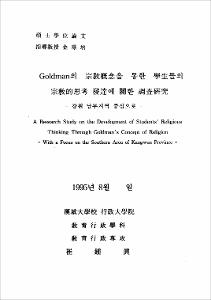Glodman의 宗敎槪念을 통한 學生들의 宗敎的 思考 發達에 關한 調査硏究
= (A) research study on the development of students' religious thinking through Goldman's concept of religion : with a focus on the southern area of Kangwon province
- Type
- Thesis
- Alternative Title
- 강원 남부지역 중심으로
- Department
- 교육행정학과교육행정전공
- Issued Date
- 1995
- Publisher
- 한성대학교 행정대학원
- Files in This Item:
-
-
Download
 000000065905.pdf
기타 데이터 / 2.5 MB / Adobe PDF
000000065905.pdf
기타 데이터 / 2.5 MB / Adobe PDF
-
Items in Repository are protected by copyright, with all rights reserved, unless otherwise indicated.